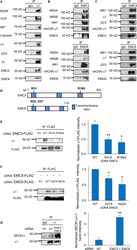Antibody data
- Antibody Data
- Antigen structure
- References [1]
- Comments [0]
- Validations
- Other assay [1]
Submit
Validation data
Reference
Comment
Report error
- Product number
- PA5-107119 - Provider product page

- Provider
- Invitrogen Antibodies
- Product name
- EMC6 Polyclonal Antibody
- Antibody type
- Polyclonal
- Antigen
- Synthetic peptide
- Description
- Sequence homology: Cow: 100%; Dog: 100%; Guinea Pig: 100%; Horse: 100%; Human: 100%; Mouse: 100%; Rat: 100%; Zebrafish: 79%
- Reactivity
- Human
- Host
- Rabbit
- Isotype
- IgG
- Vial size
- 100 µL
- Concentration
- 0.5 mg/mL
- Storage
- Store at 4°C short term. For long term storage, store at -20°C, avoiding freeze/thaw cycles.
Submitted references The endoplasmic reticulum membrane complex promotes proteostasis of GABA(A) receptors.
Whittsette AL, Wang YJ, Mu TW
iScience 2022 Aug 19;25(8):104754
iScience 2022 Aug 19;25(8):104754
No comments: Submit comment
Supportive validation
- Submitted by
- Invitrogen Antibodies (provider)
- Main image

- Experimental details
- Interactions of EMC3 and EMC6 with neurotransmitter-gated ion channels (A) Co-immunoprecipitation (Co-IP) from primary rat cortical neurons demonstrated endogenous interactions between alpha1 subunits of GABA A receptors and EMC3, EMC6, and a number of alpha1-interacting chaperones (BiP and calnexin) and ERAD factors (Grp94 and VCP). Neurons were plated onto 10-cm dishes at a density of one million per dish. At DIV 12, proteins were extracted for Co-IP. IgG was used as a negative control during the immunoprecipitation. n = 3. (B) Co-IP from primary rat cortical neurons demonstrated endogenous interactions between EMC3/EMC6 and a number of ion channels, including N-methyl-D-aspartate receptors (NMDARs, including NR1, NR2A and NR2B subunits) and nicotinic acetylcholine receptors (nAChR alpha7 subunit). n = 3. (C) Co-IP from mouse cortical homogenates, which were prepared from C57BL/6J mice between 8 and 10 weeks of age, demonstrated endogenous interactions between EMC3/EMC6 and selected ion channels. n = 3. (D) Schematic of the primary sequence of EMC3 and EMC6. R31 and R180 in EMC3 and N22 and D27 in EMC6 were reported to influence the biogenesis of EMC-dependent client proteins. (E) Mutation of R31A or R180A in EMC3 significantly reduced the interaction of EMC3 with GABA A alpha1 subunits. The cDNAs of FLAG-tagged EMC3, either in the wild type (WT) form or carrying appropriate mutations of R31A or R180A, were transiently transfected in HEK293T cells stably expressing alpha1be
 Explore
Explore Validate
Validate Learn
Learn Western blot
Western blot Other assay
Other assay